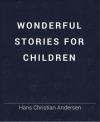Boekenkast

Wonderful Stories for Children
Auteur | Hans Christian Andersen |
Eerste Uitgave | 2006 |
Uitgave | 1846 |
Uitgeverij | Chapman and Hall |
Vorm | kortverhalen |
Taal | Engels |
Bladzijden | 127 bladzijden |
Gelezen | 2014-05-01 |
Score | 7/10 |
Inhoud
Shut-Eye (Ole Lukøje, 1842)
The Daisy (GÃ¥seurten, 1838)
The Naughty Boy (Den uartige Dreng, 1835)
Tommelise (Tommelise, 1835)
The Rose-Elf (Rosen-Alfen, 1839)
The Garden of Paradise (Paradisets Have, 1839)
A Night in the Kitchen
Little Ida's Flowers (Den lille Idas Blomster, 1835)
The Constant Tin Soldier (Den standhaftige tinsoldat, 1838)
The Storks (Storkene, 1838)
Bespreking
Sometimes dark, always fantastic
Wonderful Stories For Children collects some of the lesser known stories of the Danish fairy tale writer Hans Christian Andersen, with the one exception being The Constant Tin Soldier. The complete list of stories: Shut-Eye (Ole Lukøje, 1842), The Daisy (Gåseurten, 1838), The Naughty Boy (Den uartige Dreng, 1835), Tommelise (Tommelise, 1835), The Rose-Elf (Rosen-Alfen, 1839), The Garden of Paradise (Paradisets Have, 1839), A Night in the Kitchen, Little Ida's Flowers (Den lille Idas Blomster, 1835), The Constant Tin Soldier (Den standhaftige tinsoldat, 1838) and The Storks (Storkene, 1838).
Children’s stories have come a long way since the time Andersen wrote these little fairy tales, so it is very doubtful if any modern child would still be enraptured by the imagination captured in these little gems. All of them bathe in a pool of nostalgia that will certainly appeal to the more mature reader. The genius of the author lies in being able to elevate mundane little things to wonderfully fantastic proportions, as probably best showcased in Little Ida's Flowers, one of the longer stories of this collection. Certainly when death is the subject of a tale, which happens more than once, you get to see Anderson at his darkest. Makes you wonder what kind of impact this would have had on the youngsters of the first half of the 19th century.
The fantasy used by Anderson is quite transcendent and allegoric and will often lead to more insight after a second reading.